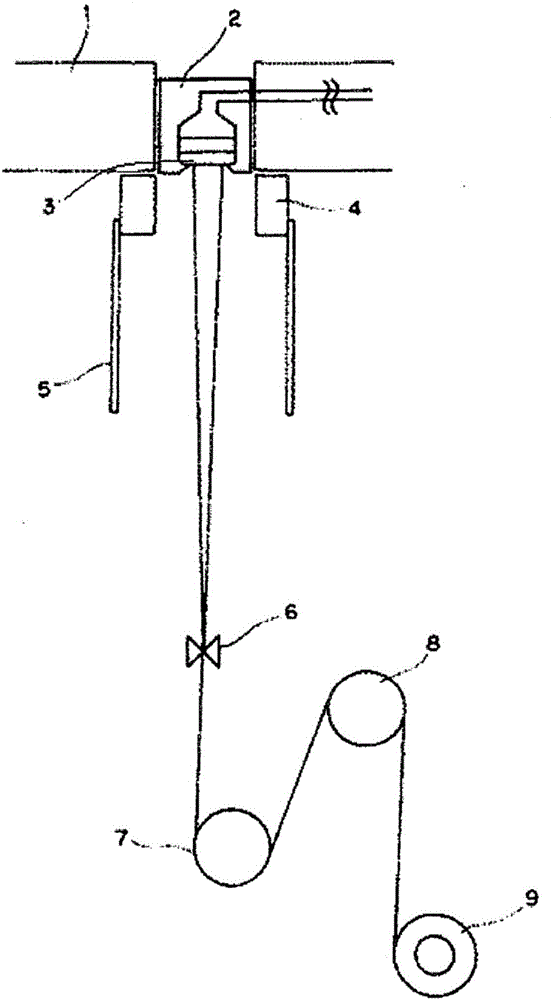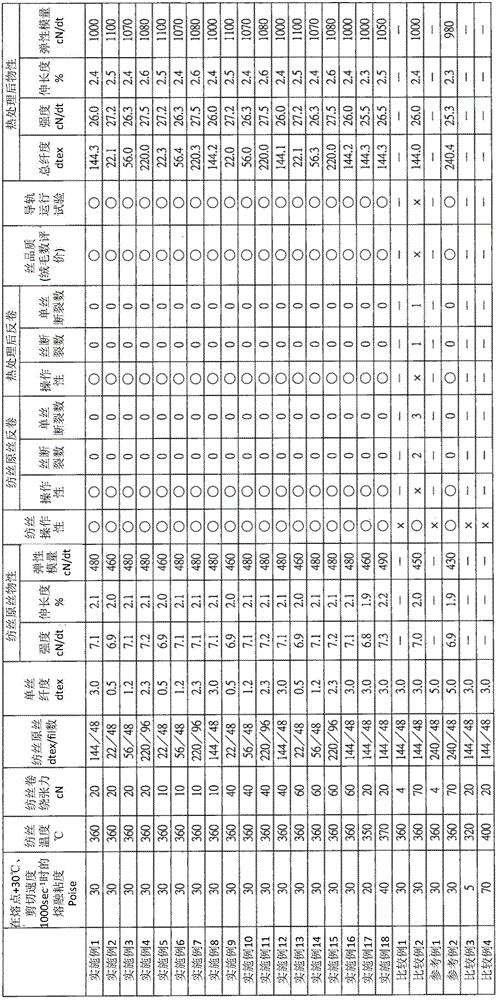Melt anisotropic aromatic polyester fiber and method for producing same
An aromatic polyester, anisotropic technology, applied in the direction of one-component polyester rayon, one-component copolyester rayon, etc., can solve the problem of stretching impossible, melting anisotropic aromatic polyester Solve problems such as low elongation at break of ester fiber, and achieve excellent passability
- Summary
- Abstract
- Description
- Claims
- Application Information
AI Technical Summary
Problems solved by technology
Method used
Image
Examples
Embodiment 1
[0078] As an aromatic polyester showing melt anisotropy, a mixture of 40 moles of p-acetoxybenzoic acid, 15 moles of terephthalic acid, 5 moles of isophthalic acid and 20.2 moles of 4,4'-diacetoxybiphenyl was used. Polymerized aromatic polyester. The melting point of the aromatic polyester is 340°C, at the melting point +30°C, the shear rate is 1000sec -1 When the melt viscosity is 30 Poise. The aromatic polyester was dried in a vacuum dryer at 140° C. for 24 hours, and after the moisture content reached 5 ppm, it was melt-extruded by a single-screw extruder, metered by a gear pump, and the resin was supplied to a spinning package. The spinning temperature from the exit of the extruder to the spinning package at this time was 360°C. The resin was discharged at a discharge rate of 11.6 cc / min from a spinneret having 48 holes with a diameter of 0.09 mm. Oil was applied to the ejected resin, introduced to the first godet, and then introduced to the second godet, and 48 monofil...
Embodiment 2~16
[0080] Using the aromatic polyester used in Example 1, spinning was carried out in the same manner as in Example 1, except that the total fineness, single filament fineness, and spinning winding tension were changed as shown in Table 1, to obtain aromatic polyester fibers. Next, in the same manner as in Example 1, the obtained aromatic polyester fiber was rewound from the spinning reel onto a heat treatment reel, treated in nitrogen, and rewound from the heat treatment reel onto a paper tube to obtain a heat-treated Aromatic polyester fiber. As shown in Table 1, the rewinding of the aromatic polyester fiber was good without occurrence of monofilament breakage or broken filaments before and after heat treatment. The number of fuzz of the heat-treated fiber was also 0 in the measurement of 1 million m, and it was of good quality. In the guide rail running test, the amount of deposits on the guide rail was small, and the process passability was good.
Embodiment 17、18
[0082] Use at melting point +30°C, shear rate 1000sec -1 The aromatic polyesters having melt viscosities of 20 Poise and 40 Poise were spun in the same manner as in Example 1, except that the spinning temperature was changed, to obtain aromatic polyester fibers. Next, in the same manner as in Example 1, the obtained aromatic polyester fiber was rewound from the spinning reel onto a heat treatment reel, treated in nitrogen, and rewound from the heat treatment reel onto a paper tube to obtain a heat-treated Aromatic polyester fiber. As shown in Table 1, the rewinding of the aromatic polyester fiber was good without occurrence of monofilament breakage or broken filaments before and after heat treatment. The number of fuzz of the heat-treated fiber was also 0 in the measurement of 1 million m, and it was of good quality. In the guide rail running test, the amount of deposits on the guide rail was small, and the process passability was good.
PUM
| Property | Measurement | Unit |
|---|---|---|
| Fineness | aaaaa | aaaaa |
| Monofilament denier | aaaaa | aaaaa |
| Melting point | aaaaa | aaaaa |
Abstract
Description
Claims
Application Information
 Login to View More
Login to View More - R&D
- Intellectual Property
- Life Sciences
- Materials
- Tech Scout
- Unparalleled Data Quality
- Higher Quality Content
- 60% Fewer Hallucinations
Browse by: Latest US Patents, China's latest patents, Technical Efficacy Thesaurus, Application Domain, Technology Topic, Popular Technical Reports.
© 2025 PatSnap. All rights reserved.Legal|Privacy policy|Modern Slavery Act Transparency Statement|Sitemap|About US| Contact US: help@patsnap.com


